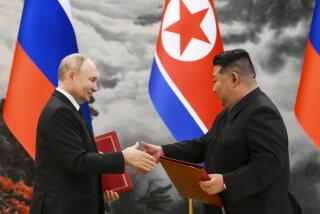Aid Groups in Dark About North Korean Flood
SEOUL — By some accounts, it was a disaster of massive proportions that afflicted North Korea in July.
Huge mudslides cascaded into apartment buildings, rising to the third floor and entombing occupants like the victims of Vesuvius before they could think about fleeing. Torrential rains elsewhere in North Korea were said to have swept away cottages without a trace, and large buildings were left with only the supporting pillars still standing.
The cataclysmic descriptions come from Good Friends, a Buddhist charity that has published several detailed reports since the rains. The Seoul-based organization has put the death toll at 54,700, which would make it the largest natural disaster in North Korea’s history.
But confusion reigns over the disaster because of the secretive nature of the North Korean regime. The government in Pyongyang acknowledged in July that flooding was a problem and canceled an extravaganza of mass gymnastics held frequently in homage to leader Kim Jong Il.
But the regime has been tight-lipped about the extent of the damage and casualties. The closest thing to a death toll has been a report in a pro-Pyongyang newspaper in Japan that said there were only 249 deaths.
Beyond the humanitarian concern, the political ramifications are enormous. The torrential rains hit July 15 and 16, just 10 days after North Korea test-fired a barrage of missiles off its east coast. No sooner had the Bush administration elicited a promise from South Korea to cut off aid than the floodwaters rose and Seoul reversed itself.
On Aug. 20, South Korea announced an aid package amounting to $230 million, including rice, blankets, cement and excavating equipment.
“These floods came at a convenient time for the South Korean government to reinforce its support for North Korea,” said Shin Ju-hyun, an analyst with Daily NK, a Seoul-based newsletter that follows North Korea.
As the aid pours in, donors acknowledge that they are operating in the dark when it comes to the floods.
“Unfortunately, we don’t have any detailed information,” said Yang Chang-seok, a spokesman for South Korea’s Unification Ministry, which handles North Korea matters. “We know from satellite photos it looks very serious, but the North Koreans have not given us data.”
Alistair Henley of the Beijing office of the International Federation of Red Cross and Red Crescent Societies said aid workers were taken to see flood damage on the outskirts of Pyongyang, the capital, a few days after the rains. Since then, however, only North Koreans working for the agency have been there.
Henley said he was skeptical, however, of Good Friends’ report of more than 50,000 dead.
“That would be much higher than the death toll in all of China, where we had eight typhoons this summer over a larger area,” Henley said.
A Western diplomat who has been looking into the reports agreed. “Even in the Hermit Kingdom, death of that scale would not go undetected,” said the diplomat, who spoke on condition of anonymity because of the sensitivity of the situation.
The Buddhist aid agency has not disclosed the sources of its information, but it is known to have good connections in North Korea and in the North Korean refugee community at the Chinese border. Buddhist aid officials were credited with providing some of the earliest warnings in the mid-1990s about an unreported famine in North Korea that is believed to have killed 2 million people.
Erica Kang, an official with Good Friends, said environmental damage in North Korea after the famine was the main culprit in this tragedy.
“The rainfall ... was not so much higher than in the past, but there was a problem with soil erosion,” Kang said. “After the hunger crisis in the 1990s, everyone was out on the mountains looking for firewood. They started terracing all the hills to grow crops. The hills are very steep and there is nothing to hold the soil.”
Kang said satellite images of the affected area confirmed Good Friends’ claims of massive mudslides, although others said the images were not conclusive.
In an Aug. 17 report on the flooding, Good Friends said about 30,000 people had died in Yangdok, 50 miles northeast of Pyongyang, where apartment buildings sat in a valley surrounded on four sides by steep mountains. The report said mud poured down the mountainsides during the night as people slept.
The area around Yangdok has been sealed off by the military.
An unnamed North Korean official was quoted in the report as saying that few people could be rescued because of a lack of heavy earthmoving equipment in the country.
The report also said floods destroyed 231 bridges, 300,000 homes and 250,000 acres of crops.
Notwithstanding the dispute over the death toll, there is widespread agreement among aid officials that the floods could have devastating repercussions for a country that has barely recovered from the last famine. North Korea is not able to produce enough food to feed its population. Despite a national ideology that extols the virtues of self-sufficiency, it has been dependent on handouts for years.
North Korea blamed the last famine on a 1995 flood, though experts believe the problem was well underway years before.
Chu Sung-ha, a North Korean defector who works as a journalist in Seoul, said the latest flood could weaken Kim’s hold on power.
“The last time we went through floods and a famine they called it the ‘March of Tribulation’ and people were told it was not the fault of their government,” Chu said. “If it happens all over again, it will be very difficult for people to believe.”
*
More to Read
Sign up for Essential California
The most important California stories and recommendations in your inbox every morning.
You may occasionally receive promotional content from the Los Angeles Times.










